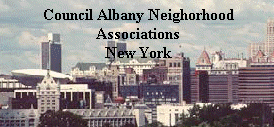ALBANY -- More than 100
neighborhood activists turned out Saturday morning, each more
than willing to present an idea or two on how to make Albany a
better place.
Members of a task force created by Mayor Jerry Jennings
called the Re-Capitalize Albany Committtee listened for a few
hours and offered mostly noncommittal answers. They stressed
that they were in a preliminary phase of their work.
"If economic development doesn't work for everybody, it
doesn't work for anybody," said Joe Rabito, city Planning
and Development commissioner.
"This is a city of neighborhoods," Rabito added.
"It's critical to bring all of the stakeholders together to
get more input."
Subcommittee chairs of the 52-member panel gave an initial
status report on its broad look into the areas of schools,
neighborhoods and economic development at the seventh annual
Neighborhood Works conference.
It was held in First Lutheran Church Hall, and was sponsored
by the Council of Albany Neighborhood Associations and the
Neighborhood Resource Center.
The task force is expected to make its recommendations to the
mayor early in 2007.
Meanwhile, the participants came to advance a variety of
agendas: from strengthening code enforcement to protecting the
Pine Bush; pushing improved public library branches to making
the city more bicycle-friendly; creating more affordable housing
to building condominiums for seniors in pedestrian-friendly city
neighborhoods.
The gathering had a tone of conviviality rather than
confrontation.
There were representatives from most of the city's 30
neighborhood associations, which stretch from downtown to
uptown, from impoverished to affluent addresses.
"I live in one of the poorest neighborhoods and we're
not well represented today," said the Rev. Joyce Hartwell,
a music impresario who lives in West Hill.
"I've gone to a lot of meetings in the last five years
and all we've done is plan and study," she said.
Michael Tucker, director of the Harriman Research &
Technology Park, said he was committed to producing workable
recommendations "that don't just sit on a shelf."
The question-and-answer period was occasionally interrupted
by applause. Attendees clapped when Julie Elson, who lives in
the New Scotland Avenue/Woodlawn neighborhood, offered what
might be called a baby-boomer boomerang scenario that drains
local resources going and coming.
Elson described that she was a state employee, nearing
retirement age, and is considering joining her cohorts
relocating to North Carolina or Florida "to spend our New
York state retirement benefits before returning to Albany when
we need long-term care."
Elson made a plug for building conveniently located,
no-maintenance condos for seniors at the Harriman State Office
campus, which is being re-visioned as a research and high-tech
park.
"I'd rather not leave Albany," Elson said. She and
her husband have two children, ages 17 and 20, and they'll soon
be both retired and empty-nesters.
Rabito said there are several hundred units currently
"going from concept to completion" in downtown Albany
that would fill the bill for Elson's requirements.
Other concerns raised included a need to expand public
transportation for the large percentage of city residents
(variously estimated 25 to 50 percent, based on different
surveys) who do not own a car and must commute from the inner
city to the suburbs for work.
Paul Grondahl can be reached at 454-5623 or by e-mail at
pgrondahl@timesunion.com.
